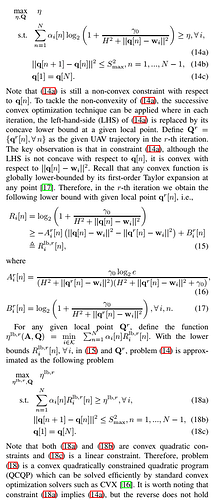my code
cvx_begin
variable Q_new(N,2)
gama0 = P * db2pow(row0) / sigma2;
% R = zeros (K,1) ;
expression R(K,1);
expression r;
for i = 1 :1: K
for n = 1:1: N
r = r + a(n,i) * ( (-gama0 * log2(exp(1)))/(H^2 + sum_square_abs(Q(n)-X(i)))/...
(H^2 + sum_square_abs(Q(n)-X(i)) + gama0) *...
( sum_square_abs(Q_new(n)-X(i))- sum_square_abs(Q(n)-X(i)) )...
+ log2(1 + gama0/(H^2+ sum_square_abs(Q(n)-X(i)))) );
end
R(i) = r;
end
eta_lb = min (R);
maximize eta_lb
subject to
norms(Q_new(2:N)-Q(1:N-1),2,2) <= Smax^2 ;
Q_new(1) == Q_new(N);
cvx_end
Error:
Error using cvx/min (line 208)
Disciplined convex programming error:
Invalid computation: min( {convex} )
Error in main (line 123)
eta_lb = min (R);
I know that my problem is convex and solution exists.
